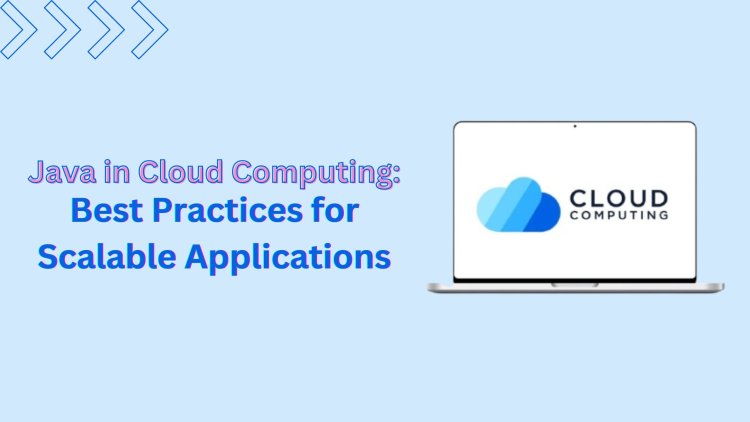Java in Cloud Computing: Best Practices for Scalable Applications
Share this Post to earn Money ( Upto ₹100 per 1000 Views )

Cloud computing has revolutionized the way businesses build, deploy, and scale applications. It offers an on-demand infrastructure, which allows organizations to increase or decrease computing resources based on their requirements. Among the most popular programming languages used in cloud-based applications, Java stands out due to its versatility, scalability, and robust ecosystem. In this blog, we will explore how Java can be leveraged in cloud computing, its advantages, and the best practices for building scalable cloud applications. Additionally, we’ll discuss why partnering with the best Java development company or cloud computing solutions provider is key to creating successful cloud-based applications.
1. Introduction to Java in Cloud Computing
Java, a highly portable, object-oriented, and platform-independent language, has been a mainstay in enterprise software development for decades. When combined with cloud computing, Java can deliver scalable, reliable, and efficient solutions that cater to businesses of all sizes. Cloud platforms like Amazon Web Services (AWS), Microsoft Azure, and Google Cloud offer Java development kits (SDKs) and tools that integrate seamlessly with their infrastructure.
Cloud computing offers three main service models: Infrastructure as a Service (IaaS), Platform as a Service (PaaS), and Software as a Service (SaaS). Java applications in the cloud can be built using any of these models, but the flexibility and scalability of Java shine the brightest in PaaS and IaaS environments.
1.1. Java's Role in Cloud Computing
Java provides several advantages for cloud applications, especially in areas of performance, security, and scalability. Java applications can run in containers, microservices architectures, and on virtual machines (VMs), all of which are pivotal in cloud environments.
Some of the key features of Java that make it an excellent fit for cloud computing include:
-
Platform Independence: Java applications are platform-independent and can run on any system that supports the Java Virtual Machine (JVM). This feature is especially beneficial for cloud platforms that offer infrastructure for different operating systems.
-
Robust Ecosystem: Java has a rich ecosystem of libraries, frameworks, and tools, which help developers speed up the development process for cloud applications.
-
Scalability: Java’s multi-threaded nature allows it to handle a large number of simultaneous users and requests, which is crucial for cloud-based applications that often deal with large-scale operations.
-
Security: Java comes with built-in security features like code access security, authentication, and encryption, which are essential for cloud applications handling sensitive data.
2. Cloud Computing and Scalability
Scalability is one of the most significant reasons businesses choose to move to the cloud. In cloud environments, resources such as storage, computing power, and network bandwidth can be dynamically adjusted based on real-time demand. This flexibility is essential for applications that need to scale efficiently to meet user demands without compromising performance.
In Java-based cloud applications, scalability can be achieved through multiple strategies:
-
Vertical Scaling (Scaling Up): Involves adding more resources (CPU, RAM, storage) to an existing server to handle increased traffic. Java applications running on cloud platforms can leverage virtual machines with higher resources, allowing them to scale up easily.
-
Horizontal Scaling (Scaling Out): Involves adding more machines or instances to the application to handle an increased load. Java applications can be deployed in containers or as microservices, which make horizontal scaling much more manageable.
-
Auto-scaling: Cloud platforms like AWS, Google Cloud, and Azure offer auto-scaling services that automatically adjust the number of instances based on traffic load. Java applications can leverage these auto-scaling capabilities to ensure optimal performance and resource usage.
3. Best Practices for Building Scalable Java Applications in the Cloud
Building scalable Java applications in the cloud requires following certain best practices to ensure that the application can handle an increasing number of users, requests, and data while maintaining high availability and performance.
3.1. Microservices Architecture
One of the best practices for building scalable Java applications in the cloud is using microservices architecture. Microservices are small, independent services that work together to form a complete application. This architecture is highly scalable because each microservice can be scaled independently depending on its usage.
For Java developers, Spring Boot and Spring Cloud are popular frameworks for building microservices. These frameworks provide the tools necessary to create lightweight, stateless, and independently deployable services that can run in containers or cloud environments.
Benefits of microservices for cloud scalability:
-
Each microservice can scale independently based on load, optimizing resource utilization.
-
Fault isolation: If one microservice fails, the others continue to operate, reducing the impact of failures.
-
Easier deployment and maintenance of individual components.
3.2. Use of Containers and Kubernetes
Containers, particularly Docker, have become the de facto standard for packaging and deploying applications in the cloud. Containers encapsulate an application and its dependencies, ensuring consistency across environments. Java applications can be packaged in containers and deployed on cloud platforms for enhanced portability and scalability.
Kubernetes is an open-source platform for automating the deployment, scaling, and management of containerized applications. Kubernetes helps manage containers across a cluster of machines and ensures the availability of Java applications by handling load balancing, automatic scaling, and self-healing.
Benefits of using containers and Kubernetes for scalable cloud applications:
-
Simplified deployment and scalability through container orchestration.
-
Reduced overhead in managing infrastructure resources.
-
Enhanced application portability across different cloud providers.
3.3. Leveraging Cloud Services
Cloud platforms offer various managed services that can enhance the scalability of Java applications. Instead of building everything from scratch, developers can use cloud services for databases, messaging queues, caching, and more. These services are optimized for scalability, high availability, and reliability.
Some essential cloud services for scalable Java applications include:
-
Cloud Databases: Managed databases like Amazon RDS, Google Cloud SQL, or Azure SQL Database offer automatic scaling, backups, and high availability. Java applications can interact with these services using JDBC (Java Database Connectivity).
-
Message Queues: Cloud-based message queues like Amazon SQS or Google Pub/Sub can handle asynchronous communication between microservices, ensuring smooth scaling even during high traffic periods.
-
Caching: Cloud-based caching solutions like Amazon ElastiCache or Redis help improve performance by caching frequently accessed data, reducing the load on databases and improving response times.
3.4. Implementing Auto-Scaling
Auto-scaling is a critical feature for Java applications running in the cloud. Cloud providers like AWS, Google Cloud, and Azure offer auto-scaling capabilities, which automatically adjust resources based on demand. For Java applications, auto-scaling ensures that the application can handle increased traffic during peak times and scale down when the demand decreases.
Java applications can take advantage of cloud auto-scaling features by:
-
Setting up auto-scaling policies based on specific metrics such as CPU utilization, memory usage, or response times.
-
Using load balancing to distribute traffic across multiple instances, ensuring even distribution of workloads.
3.5. Implementing Fault Tolerance and High Availability
Scalability is not only about handling more traffic but also about ensuring high availability and fault tolerance. Cloud computing provides the necessary infrastructure to build highly available applications by distributing workloads across multiple availability zones and regions.
Best practices for ensuring high availability in Java cloud applications:
-
Redundancy: Deploy Java applications across multiple availability zones (AZs) or regions to ensure that if one zone or region fails, the application remains operational.
-
Load balancing: Use load balancers to distribute incoming traffic across multiple application instances, ensuring that no single instance is overwhelmed.
-
Health checks: Configure health checks to monitor application instances. If an instance fails, it can be automatically replaced with a healthy instance.
3.6. Continuous Integration and Continuous Deployment (CI/CD)
Continuous Integration (CI) and Continuous Deployment (CD) practices help ensure that Java applications are always up to date, secure, and scalable. CI/CD pipelines automate the process of building, testing, and deploying applications, making it easier to release new features, fix bugs, and maintain scalability in the cloud.
By using CI/CD tools such as Jenkins, GitLab, or CircleCI, Java developers can automate the deployment of microservices or other components, ensuring that the application remains scalable and up-to-date across different cloud environments.
3.7. Monitoring and Performance Optimization
Regular monitoring and performance optimization are essential for maintaining the scalability of Java applications in the cloud. Tools like Prometheus, Grafana, AWS CloudWatch, and Google Cloud Monitoring provide real-time insights into application performance, resource usage, and system health.
Key monitoring metrics to track for scalability:
-
Latency: Monitor the time taken by Java applications to respond to requests and scale resources accordingly.
-
Throughput: Track the number of requests or transactions processed by the application.
-
Error rates: Monitor the frequency of errors or failures in the application to proactively address potential scalability issues.
4. Why Choose the Best Java Development Company for Cloud-Based Applications?
Developing scalable cloud applications requires expertise in both Java and cloud technologies. Choosing the best Java development company or a company specializing in cloud computing solutions can ensure that your cloud applications are optimized for performance, security, and scalability.
The top Java development companies possess the skills and experience to integrate Java seamlessly with cloud platforms, ensuring that your application can scale efficiently as your user base grows.
Additionally, working with companies that offer Android app development services allows you to create cloud-connected mobile applications that can leverage the power of the cloud while providing an excellent user experience on Android devices.
5. Conclusion
Java's robust features, security, and scalability make it an ideal choice for building cloud-based applications. By following the best practices discussed in this blog—such as leveraging microservices, containers, auto-scaling, and cloud services—developers can create scalable, high-performance Java applications that can meet the demands of modern businesses.
For companies looking to leverage the full potential of Java in cloud computing, partnering with the best Java development company or cloud computing solutions provider is essential. These experts can help ensure that your applications are scalable, secure, and optimized for the cloud, enabling you to achieve your business goals while staying ahead of the competition.













